
|
And Things That Go Bump In The Night: Mini-Monsters by Richard L. Howey, Wyoming, USA |
Scottish Prayer
Traditional
From ghoulies and ghosties
And long-leggedy beasties
And things that go bump in the night,
Good Lord, deliver us!
Many Victorians were attracted to Natural Theology, the view that God’s glory and creativity is manifest in Nature and reveals His (no feminists in the church at that point) sense of purpose and design through the beauty of His creations. A comforting view, for among other things, it meant that one could forgo a stultifying sermon on a lovely Sunday and worship God by instead walking through the woods collecting wildflowers or butterflies. While there is a certain Romantic charm in such a perspective, there is also a deep-rooted naivety–it omits a consideration of mosquitos!

There is hardly a place on Planet Earth where one can escape these tiny minions from Hell. Even some scientists who are mosquitologists admit, nay, argue strenuously that these creatures have no positive role in the balance of things and their complete annihilation would only be a benefit. Just take a closer look at this hideous little monster in the image above with her (yes, I’m sorry ladies; it’s the females who bite) long, hypodermic-like proboscis. While mosquitos are relatively small, they, unfortunately, breed in staggering numbers. I remember reading an account of 19th Century fur trappers on horseback in Northern Canada, who would have to stop regularly to clear the nostrils of their horses from masses of mosquitos.
Even modern biologists have an inclination to celebrate those many beautiful marvels of Nature, many of which are stunning. However, such attitudes ignore the dark side of Nature or the Mothers of Being as Goethe referred to them. The Romanticizing of Nature is often possible only from a distance, “recollected in tranquility” in the comfort of one's book-lined study.
Many of our judgments regarding the good, the bad and the ugly in Nature are a consequence of size and that functions in all kinds of fascinating ways. A 0.5 inch Amoeba, flowing and forever changing form, is an entrancing spectacle , but a 50 foot Amoeba would indeed strike us as a monstrosity and a horror. Yet we marvel at the giant cetaceans; a Humpback whale is a wonder to behold as it dives and displays.
We are indeed glad that certain organisms cannot, for biochemical and biophysical reasons, exceed a certain size, yet in many instances, why this is the case remains a puzzle and is still poorly understood. Below is an image of a centipede which is nearly a foot long, which is about the modern limit, but there is a record of a fossil specimen which is 40 inches in length.

Undoubtedly, there is an elaborate interplay of factors involved: genetics, environmental conditions, the availability of food, predators, parasites and the abilities of the organisms to develop devices for defense and weapons for predation. At a naive and uninformed level (and that’s certainly where I am), we might ask why it is that centipedes were limited in size in ancient times to a bit over 3 feet.
The problem of size is intriguing in a number of respects. For the moment, let’s focus on protozoa where we find sizes ranging from just 1 or 2 microns to giant amoeboid forms that reach over 6,000 microns in length. You will recall that 1 micron is 1/1000th of a millimeter and certainly pushes the limits of the optical microscope in terms of resolution and contrast. Within this group, to find organisms that are 6,000 times larger than its smallest members is astonishing. In examining this issue, one has to remember that it is not simply a matter of length, but of volume as well. With amoebae, when the organism reaches a certain critical size, it reproduces by dividing, thus reducing both its length and its volume.
With regard to algae the size range is even more mind-boggling. Again there are some algal forms which are only about 1 micron in size on up to the giant kelp (Macrocystis) which can be up to 200 feet in length, or 60,960,000 microns! The largest mammal is a cetacean, the Blue Whale, weighing in at up to 175 tons with a length of nearly 100 feet. The smallest mammal is Kitte’s Hog-nosed bat weighing only 2 grams and with a length of 30 millimeters. And the largest dinosaur is Argentinosaurus with a length of 120 feet and a weight of nearly 100 tons. The smallest was Microraptor with a length of only 2 feet. So, within a given group, there can be staggering variations in size and volume.
If we consider protozoa and other micro-organisms, there is a size limitation which is a consequence of the ratio of surface area to volume. Surface area is critical to these organisms, because many basic functions are carried out at or near the surface of the enclosing membrane. As we look at the evolution of more complex organisms, we realize that a series of solutions to that problem was achieved through the development of a wide variety of internal organs where the area of necessary contact with the external environment by means of the membrane was greatly reduced. These strategies allowed, in significant part, for the development of larger and larger creatures. Nonetheless, a number of significant challenges remain for us to obtain a deeper understanding of the problem of the limitations on size. Nature, ever the trickster, once again goes counter to our “intuitions”, for we are generally strongly inclined to think that the biggest and baddest creatures are insatiable carnivores seeking out great slabs of meat, such as, the Great White Shark or Tyrannosaurus rex; yet the largest of the sharks, the Whale Shark and the Blue Whale are plankton feeders and the Argentinosaurus and Apatosaurus were vegetarians.
In the rest of this essay, I want to be a bit playful regarding this issue of size in order to point out how important the matter of our size, in relation to many other organisms, is, for our survival. Just for fun, let’s begin with a visual comparison between our ancient mosquito embedded in amber and one of the world’s largest beetles–the Goliath, a handsome fellow but, I’m not sure I’d want to encounter him were he 10 times his present size, for that would make him about 5 feet in length; not a beastie that you’d want to meet in a dark alley.

With many insects, a major limiting factor with regard to size is the spiracles which involve respiration. Nonetheless, the fossil record suggests that there were some very large dragonflies with a wingspan of over 25 inches and even today we have giant moths with wingspans of 12 inches, the Atlas moth. I mention these examples just in case you thought that things were getting too easy. Flying consumes enormous amounts of energy–just ask any airline–and so, streamlining is generally the rule. However, look at the lumbering bumblebee–rather like a cargo transport plane in its bulk–and its ability to fly is really quite improbable, but it manages. Large beetles, such, as the Goliath do have wings but, if they fly at all, it’s rather like an overloaded freight plane making brief hops along a runway. However, let’s get back to the visual comparison. The mosquito is about a quarter of an inch long and the Goliath is nearly 6 inches long.

However, even this image doesn’t really adequately convey the size difference but, it does give us an idea of how we need to approach the issue of relative size.
Even among pesky creatures, there are some that have a quite charming appearance. Not long ago, I obtained a few 19th Century slides and I want to share 2 of them with you. The first one is rather whimsical and has the apposite name of the Merry Dancer.

However, if you take a close look at the head and then imagine this creature having a 10 foot wing span, the charm quickly evaporates.
The second example, although interesting, doesn’t seem charming at all; it looks too much like some aggressive wasp. It is know as the St. Mark’s Fly.

And even at this size, this is not the kind of critter that you want flying around your bedroom at night. It might be a mini-vampire with formidable blood-sucking mouth parts like a blowfly. However, you can relax, for St. Mark’s fly feeds on vegetation and the blowfly feeds on rotting carrion but, the mouth parts do indeed appear frightening.

Many people suffer from arachnophobia and my late sister-in-law was a classic example. Even the smallest, cutest, little spider would elicit panic. In all honesty, I admit that I very much dislike large spiders and am apprehensive around medium-sized spiders but, some of the wee ones are quite amusing and the larger ones are very intriguing but repellent, in part, because they are so bloody alien–come on, 8 eyes!, give me a break!

(However, it should be noted that some have 0, 1, 2, 4, or 6 eyes.) Females that devour the male after mating–sorry, I’m not interested in becoming baby food. Plus a hairy face fitted with fangs! Now I know that there are arachnophiles out there who will take umbrage at my views, so let me reiterate: I think crab spiders and little jumping spiders are rather cute and I quite marvel at the color patterns of such sizeable specimens as the Gold Orb spider. The webs, particularly when laden with sparkling drops of morning dew, are quite lovely and the spinnerets are incredible and their extraordinary ability to create several different kinds of silk, at least one of which has a proportionately higher tensile strength than a steel fiber is an astonishing feat. Nonetheless, I don’t want to tickle a tarantula or finger wrestle a wolf spider.
In the aquatic environment, we do have a few water spiders, one of the most remarkable of which has the ability to build a nest underwater by creating a submarine water bubble home where it can nosh on its prey in comfort. There are also some spider relatives, namely water mites which can be frenetically active and they are quite colorful; some of them are yellow and black, some greenish in hue, but the most common form which I encounter is bright red. As they scramble around in the water, they appear to be quite smooth but, under a stereo microscope, you immediately discover that they are, like Esau, very hairy. (Genesis 27:11 and Beyond The Fringe) However, these busy little bodies have only 2 eyes which along with their color and busyness makes them more charming than the average spider.

Earlier, we looked at the Goliath beetle, which in spite of your squeamishness, I find quite magnificent. Just look at that rich walnut brown as it contrasts with the cream-colored striping.

So, let’s take a look at three other examples of beetles which I find splendid but, I am glad they are not much larger or they would be quite unsettling indeed if you heard them come bumping up your staircase in the middle of the night.
The first is a stag beetle and one look tells you that even in its present size of 4 inches, it could give you a painful pinch.

When I was a boy, a friend of mine and I were sharing a tent at Boy Scout camp. One morning, we got up, dressed and headed up the trail to the lodge for breakfast. I was talking to my friend about some ferns along the trail and asked him a question, however, I received no answer. When I turned to look at him, I saw him on the ground near the tent, tearing at his right shoe. I ran back and just as I arrived, he succeeded in ripping off his shoe and dumped out a stag beetle which had evidently crawled in during the night. It clearly had made its presence known to his foot and this one was only about 2 inches long. Clearly a 20 or 50 footer would be a terrifying adversary. Many Grade B sci-fi movies have made use of this idea of giant insects thus playing on deep instinctual fears that humans have regarding strange creatures.
One of my favorite beetles is Eupatorus which is a rhinoceros beetle. The elytra or wing-cases look as though they were made of walnut and the anterior end with all its spikes appears to have been carved from ebony. What a magnificent creature to discover sitting on your headboard on a dark and stormy night.

Imagine a couple of males of these the size of elephants doing battle for a lady fair.
The third example is Lamprina. The mandibles of this organism defy description, so I’ll give you a sneak preview.

Imagine confronting this beastie if it were 10 times larger or you were 10 times smaller. You take a look at Lamprina you think: Hey, I thought WE invented the saw!” The colors of this organism are splendid and this brings me to a brief digression about photographing beetles. A sizeable number of beetles manifest iridescence and, as the angle of the light shifts, so do the colors. This creates significant challenges and sometimes the only solution is to take images from a variety of perspectives and illuminations.
Let’s take another look at the centipede, certain a creature that can rattle one's sensibilities. There are the little garden types which I encounter routinely and are simply matters of curiosity (which means that some day I intend to write an essay about them). The specimen we looked at is however an entirely different matter and is a Scolopendra from tropical climes and is a foot long! Not, however, the kind of thing that you would want to pop into a hotdog bun. Here it is again, in case you’ve forgotten its regal splendor.
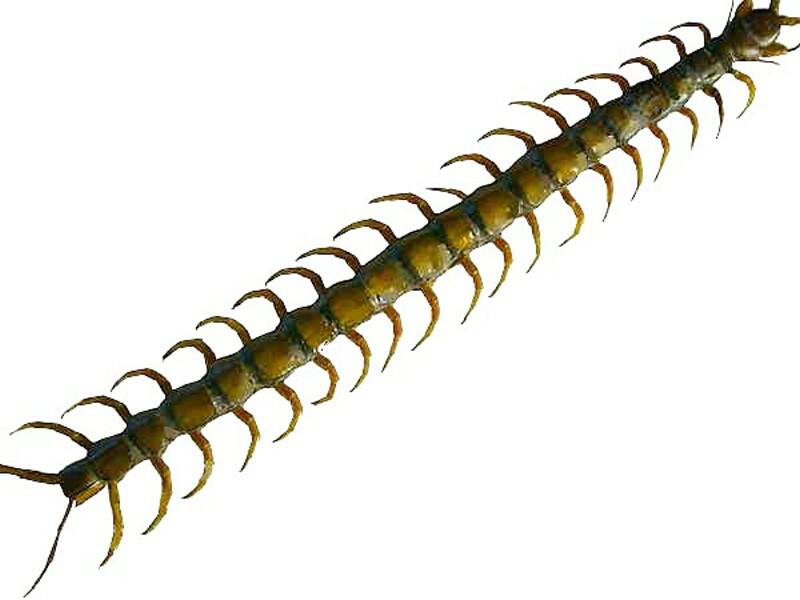
These have a poisonous bite, rarely fatal, but extremely painful. Now, image this lovely at 10 feet in length slithering up your staircase at night and bumping against your bedroom door.
For those of you who are worm lovers, I have 2 special treats for you. The first is a bristle worm which is about 5 inches in length and possesses golden, bronze bristles.

One might think of it as an aquatic porcupine, definitely, not the sort of beastie that inclines you to pet it or cuddle it nor even to go swimming with it. However, he is a rather handsome, if formidable-looking fellow compared to our next example which has what I regard as a deeply ironic name: Aphrodite. The biologist who bestowed this designation was either possessed of a wildly quirky sense of humor, slightly mad, absolutely clueless, or all three. This is one UGLY worm! First, I’ll show you the top view and then I’ll show you the underside where you can see the segmentation and know thereby that the first image is not simply a picture of a clot of mud.
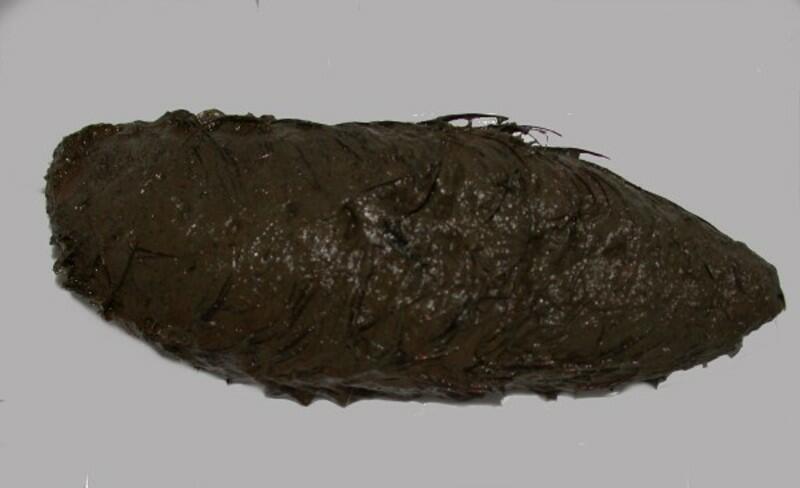

Using our size expanding machine, imagine finding an 8 foot version of one of these sloshing around in your bathtub.
Aphrodite is a scavenger and belongs to a very interesting group of annelids called “scale worms”. Underneath the brown muck on its back, which is largely an accumulation of sediment which has fallen down from above along with various sort of algae, diatoms, and other micro-critters which have taken up residence, is a series of opalescent scales. It also has setae which have extraordinary optical properties.
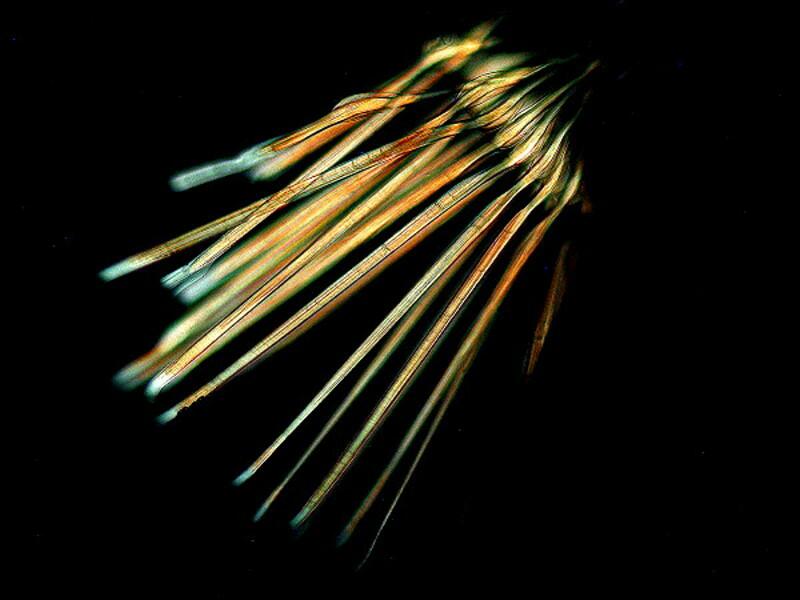
So, while it will never be regarded as a manifestation of the “goddess of beauty’, it is, when properly cleaned up and groomed, a quite presentable organism with a series of intriguing properties.
Finally, we’ll take a look at 2 bizarre insects. If you later decide you want to know about these strange beings, you can find an earlier article here. The first one, which is a scale insect, I found on a False Auralia. The adult form looks like a fleck of dried skin or dandruff which has fallen on the leaf and, although it is stationary, it is actively feeding and breeding. Here is a glimpse of one.
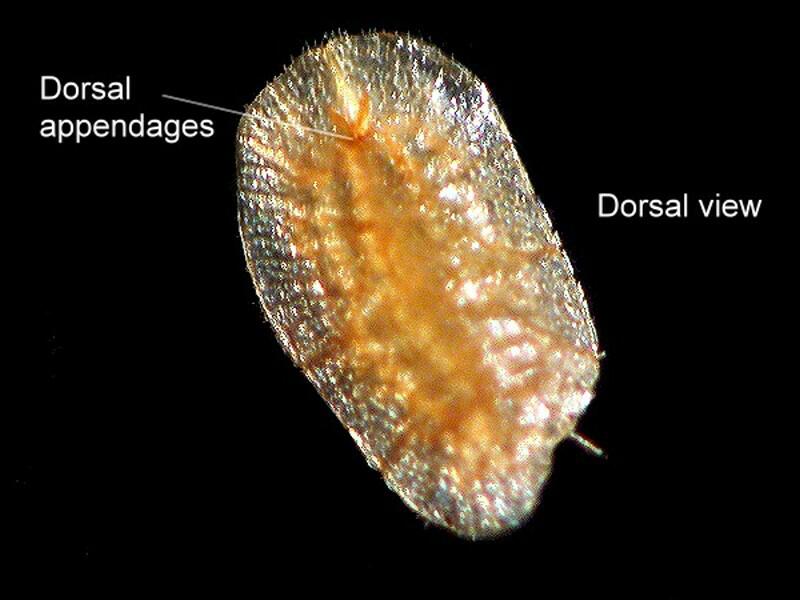
Once it reaches this stage, it remains essentially fixed and fixated on producing progeny which are called “crawlers”. This a good descriptive name for they don’t stray very far from “mommy”, who, by the way, produces these little charmers in very large numbers.
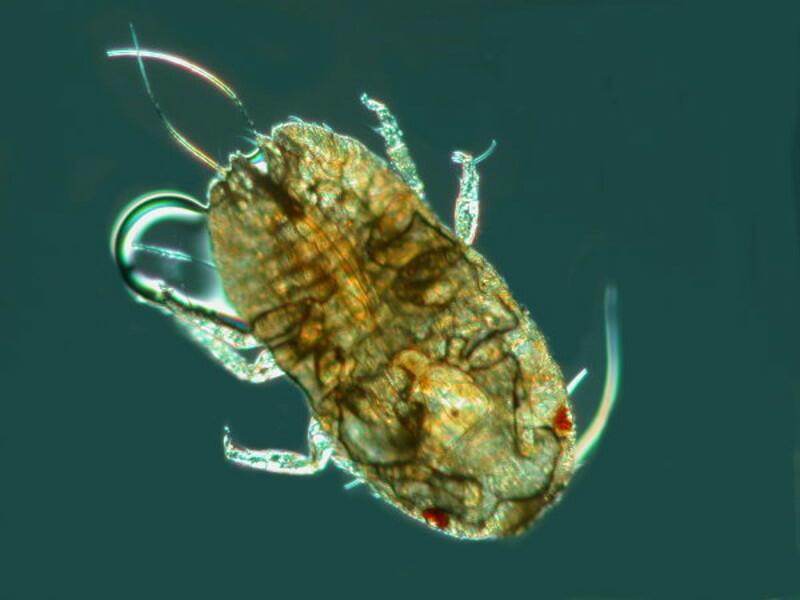
The offspring don’t go very far before finding a spot to begin feeding and they too quickly become stationary and start breeding. As you can image, all of the activity takes a significant toll on the plant and in a relatively short time. In the image above, before the crawler has produced its “scale shell”, you can see its appendages and its 2 brilliant red eyes. Now, imagine some 2 foot specimens of these invading your bed and nibbling on your toes or more likely vampirically sucking blood from them since that’s the way they feed off of plants.
Our final haunting beastie is a spittle bug which I find every summer on our juniper bushes. Usually about midsummer, the junipers begin to appear as though they were flecked with bits of styrofoam. I battled them for years and then it occurred to me that I had never taken any samples to see what kind of insect was producing this odd phenomenon. These creatures insert a long, sharp, needle-like proboscis into the juniper leaf (needle) with surgical precision, siphon off the sap, and from the waste which they aerate, create bubbly masses which gradually cover the entire insect. These are creatures that nightmares (and Grade B Hollywood sci-fi movies) are made of. Here is an image of one which I extracted from its bubble-wrap house.
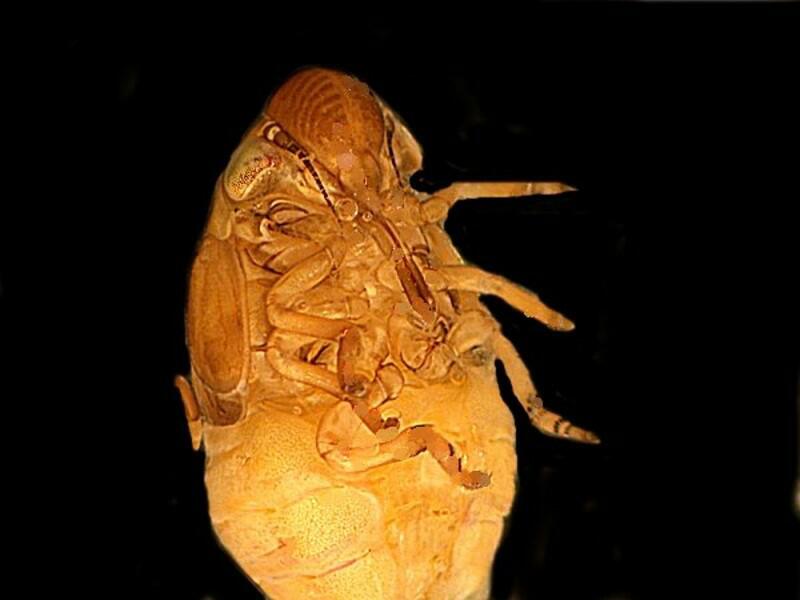
And here is one attached to a leaf still feeding, from which I have scraped away most of the bubbles.
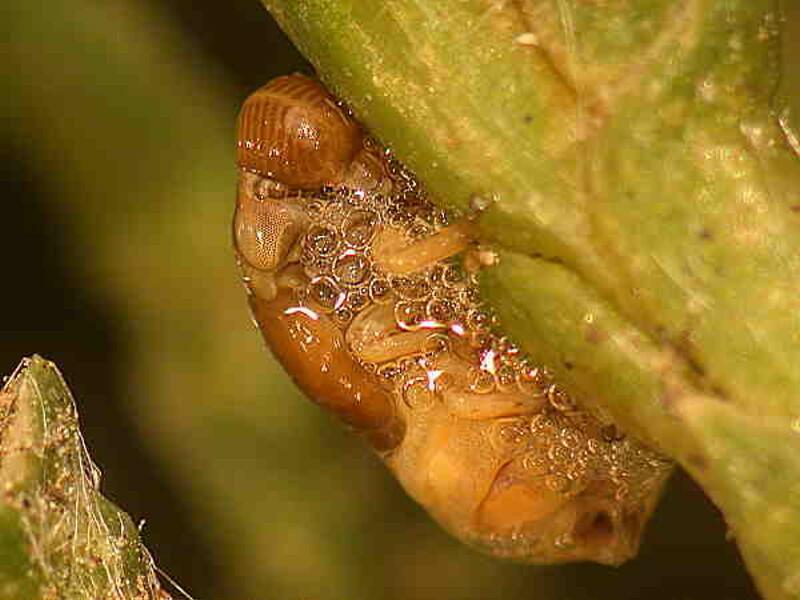
And finally, a closeup of the head of a demonic being worthy of the fantasies of Heironymus Bosch.
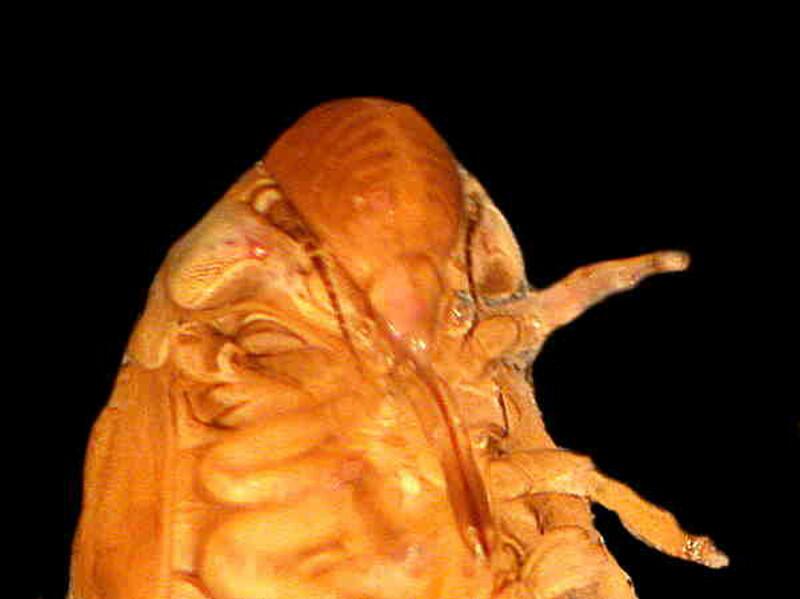
Look at the proboscis and those eyes! imagine waking up and finding a 6 foot version of one of these hovering over you hungrily. As Kurtz said: The horror! The horror!”
Pleasant dreams.
All comments to the author Richard Howey are welcomed.
Editor's note: Visit Richard Howey's new website at http://rhowey.googlepages.com/home where he plans to share aspects of his wide interests.
Microscopy UK Front
Page
Micscape
Magazine
Article
Library
Published in the February 2013 edition of Micscape Magazine.
Please report any Web problems or offer general comments to the Micscape Editor .
Micscape is the on-line monthly magazine of the Microscopy UK website at Microscopy-UK .
©
Onview.net Ltd, Microscopy-UK, and all contributors 1995
onwards. All rights reserved.
Main site is at
www.microscopy-uk.org.uk .